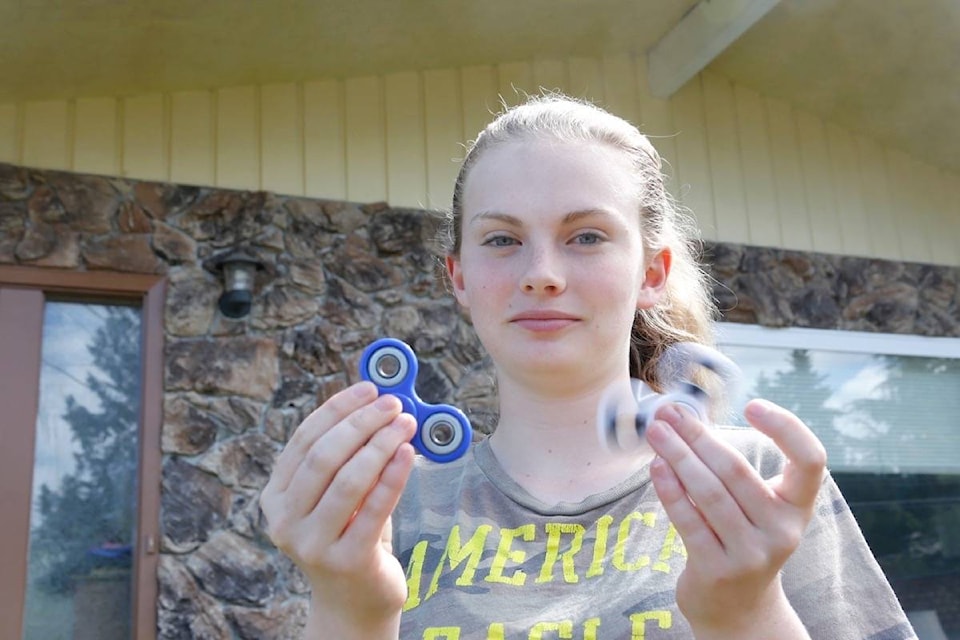They’re just about everywhere: in schools, in book stores, toy shops, home improvement outlets, and in the hands of many School District 69 students, as well as others across the globe.
They’re also being destroyed en masse in Germany, and being introduced to an orangutan in Austria.
They’re called fidget spinners, and if they’ve got your head spinning, you’re not the only one.
The spinners are small, hand-held devices with a bearing at the centre and weights around the edge. They are held at the centre bearing and spun between the fingers, on a table, or while passed between friends.
That’s what people can do with them. But what they can do for people is much debated.
Proponents of the toy, originally invented in 1993 according to the New York Times, say it’s a tool to reduce stress or help people on the autism spectrum or with ADHD to focus by giving their overworked senses something occupy them.
A Kickstarter campaign for a “fidget cube” to do just that in 2016 kicked off a craze that saw the spinners rise in popularity, and go from supposed tool to toy.
Qualicum Toy Shop began selling the spinners about two months ago, said owner Shelley Ross.
They are also being sold at local dollar stores, at Mulberry Bush Book Store and many other local businesses.
Rachel Chambers, a 12-year-old at Springwood Elementary School, said she first heard of fidget spinners about three months ago.
“On Instagram I saw these videos of fidget spinners, and my friend had sent me cool videos of them also. She was really obsessed with them.”
At first she didn’t get the point, she said. Most of the kids at her school weren’t using them properly, instead throwing them around and whatnot.
But once she tried one for herself, she changed her mind. Now Rachel has four of the spinners, and takes them pretty much everywhere.
“It helps me focus a little bit,” she said. “They are good if I’m mad at my sister or something and we’re fighting… it’s just good to spin it. A lot of my classmates are fidgety, and we use them.”
“When she’s talking, she uses them quite a bit,” said Rachel’s mom, Heather. “If she’s had a bad day, she will stand in the kitchen and yack with me while she’s spinning her fidget spinner. (It) kind of helps her concentrate her thoughts a little.”
Rachel estimates more than half of her classmates have the toys, adding they are starting to get on their teachers’ nerves.
“I know my teacher’s not a big fan of them,” said Rachel.
Deirdre Janssen, a Grade 1 teacher at Oceanside Elementary, said she doesn’t let her students use them in class, even though one of her sons is on the autism spectrum.
“The whole point of a fidget toy is for the child to be able to hold something in their hand, like my son has one in his class, where it’s supposed to be small, and it’s inconspicuous and it doesn’t distract the learning of any other students,” said Janssen. “It gives the body a sensory stimuli to hold onto something, and it keeps the body busy so that the mind can focus.
“There are tons of different fidgets out there: squishy balls, some kids have play doh, stickers, all those kinds of things.”
But the problem now is the spinners are being marketed to everyone as a toy — some make noise and others light up — though kids still try to justify using them as a tool to focus.
“Even my own son is trying to justify the use of them in class because of the claims of it being a fidget (tool), but they are not using them as a fidget,” said Janssen.
Even if they’re used properly, some therapists say there is no evidence that fidget devices help with focusing or stress, while others claim they do, according to dozens of news articles in the mainstream media attempting to give a ruling on the devices.
Dr. Wilma Arruda, a Nanaimo pediatrician and advocacy chair for the B.C. Pediatric Society, said she’s not convinced the spinners have much value at all, and worries they could distract from more healthy pursuits.
Though she notes that, if research comes out claiming otherwise, she might change her mind.
“I think right now we are in a world of mostly opinion rather than actual documented research on these things,” she said.
Arruda said she doubts the spinners have much of a positive effect for kids in general, though she feels they might have some small benefit for some children with conditions like autism or ADHD.
Considering the spinners’ popularity, her worry is that they are another sedentary activity that keep kids from being physically active and getting their “fidgety-ness” out in more healthy ways.
“I don’t think I would recommend a fidget toy to my families,” she said.
Janssen said the way spinners are being used by most students now, they have no educational value.
Rachel Chambers’ mom and dad, on the other hand, said they don’t quite get how it works, but that they have no problem with the toy.
“I’d rather the kids have those than phones in class,” said Heather Chambers.
Ross said her five- and seven-year-old kids have fidget spinners of their own. “They go walking around with them balanced on their finger. They are fun, right? There are worse things to do with your time, for sure.”
